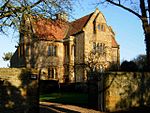Blisworth Arch
1837 establishments in EnglandBridges completed in 1837Grade II listed bridgesGrade II listed buildings in NorthamptonshireRailway bridges in Northamptonshire ... and 1 more
Use British English from February 2023

The Blisworth Arch is a railway bridge in Blisworth, Northamptonshire, in eastern England. It was designed by Robert Stephenson for the London and Birmingham Railway and completed in 1837. It is a grade II listed building and a significant local landmark.
Excerpt from the Wikipedia article Blisworth Arch (License: CC BY-SA 3.0, Authors, Images).Blisworth Arch
Towcester Road,
Geographical coordinates (GPS) Address External links Nearby Places Show on map
Geographical coordinates (GPS)
| Latitude | Longitude |
|---|---|
| N 52.180883 ° | E -0.936221 ° |
Address
Towcester Road
NN7 3DR
England, United Kingdom
Open on Google Maps









